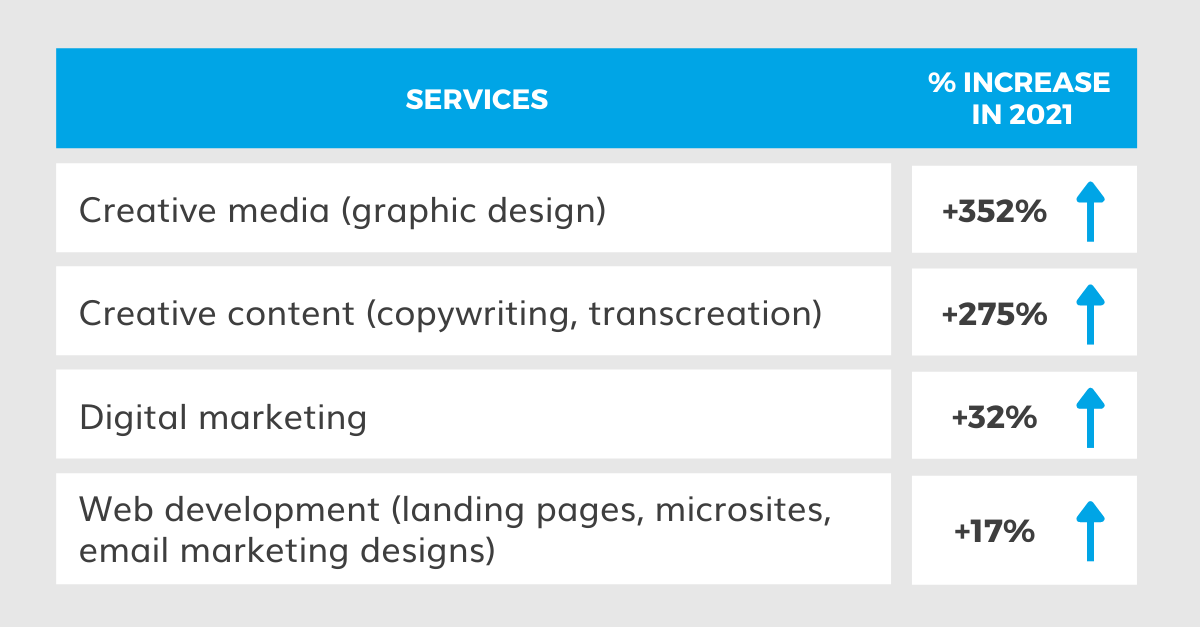In 2020 and 2021, brands’ approach to international marketing was largely governed by the rapid changes brought about by COVID (and its fallout). Now that brands have discovered a clearer path forward, the top international trends center around putting people first. Whether it’s localization, creative, or marketing trends, 2022 is the year of people power.
From the great resignation to the growing power of labor groups, people globally continue to reevaluate what matters to them. And they’re shifting their purchasing (and working) behavior to match. As we enter year three of living with COVID, the brands that will be most successful are those that display digital empathy and put people (and brand purpose) first.
RETAINING BRAND PURPOSE
Before the pandemic, brand purpose was important; now, it’s non-negotiable. Consumers care more about brand purpose than ever before. And they’re more open to considering and purchasing from companies living their brand purpose. From worker strikes to brand boycotts, consumers aren’t afraid to be loud when brands fail to live up to their ideals.
Brands need to be cautious not just of how they’re conveying their message, but where they’re conveying it. Association with publishers that promote disinformation and racism can be detrimental to brand sentiment. Organizations like Check My Ads offer services to help brands take back control while cutting off funding for hate speech and disinformation.
MARKETING TRENDS 2022 (EXPERIENCE IS EVERYTHING)
In the world of digital marketing, things are changing – fast. Global brands need to focus on improving user experience at every turn, or they’ll find international users will take their business elsewhere.
2022 core web vitals.
If global user experience is sub-par, your 2022 SERP rankings will take a hit. This update will place less emphasis on traditional SEO practices and a greater organic ranking weight on UX. Site speed and rich media formatting will be key components of these new UX rankings. With the added complexity of international, you’ll need to test your site’s performance in key markets (using a local expert or VPN) to measure page load speed, ensure proper formatting, and address any technical issues slowing you down.
Cookie phase-out.
The consumer fight for online privacy continues. Google announced they won’t be building “alternate identifiers to track individuals as they browse across the web.” Nor will they use them in their products. Many marketers have already adapted to a “cookie-light” experience in response to GDPR. But they’ll need to get creative to adapt their digital strategy for Google-dominant countries outside of the European Union.
For some, this means investing in marketing automation with greater reliance on AI and predictive modeling. Others may increase reliance on third-party data vendors, or try to get more first-party data from users through gated content. Whichever route you take, focusing on user experience will be key:
- Deliver exceptional in-market content, based on local market trends & interests
- Invest in your international SEO strategy
- Advertise where your audience goes for related content
Web accessibility.
Web accessibility allows everyone, including people with disabilities, to perceive, understand, navigate, and interact with the internet. From the Americans with Disabilities Act to the EU Web Accessibility Directive, compliance with website accessibility standards is growing in importance. And the number of accessibility-related lawsuits is growing, too. This has spurred the rise in automated website accessibility overlays/tools. But they’re not a silver bullet to achieving accessibility for people with a wide range of disabilities. Since the tools only detect 25%-30% of issues, the remaining 75% require manual checking by a person.
Micro-influencers: People-based marketing.
Micro-influencers – accounts with 10k-50k followers – are now surpassing macro-influencers in brand adoption. Because of their size and perceived authenticity, these smaller accounts have built relationships with followers based on trust and expertise. They’re more likely to reach out to partner with brands they truly care about. This offers a unique opportunity for companies to reach a targeted, highly engaged audience. Coca-Cola recently partnered with hand-picked micro-influencers in Belgium to highlight how seamlessly their products fit into their lives. Spanning travel, food, sports, and fashion verticals, the campaign enabled Coca-Cola to get in front of this harder-to-reach European market.
LOCALIZATION: INCLUSIVE & GLOBAL FIRST
The biggest trends in localization for 2022 also center on people.
Inclusivity in language.
As gender awareness continues to move out of the binary, companies have struggled to keep up, especially in international spaces. Some languages (like Turkish) already have gender-neutral pronouns. But languages like Spanish, French, Portuguese, Italian, and German (which all include gender as part of their grammar) pose greater challenges.
To address this, inclusivity marketing is on the rise. Many global brands are adapting style guidelines specifically on how to write in an inclusive and brand-appropriate way in each target language. Some are opting to re-work the copy on their international sites using new grammatical constructs that either encompass all genders or are genderless.
A gender-inclusive experience is quickly becoming table stakes in international marketing. Global consumers simply won’t put up with brands that refuse to include them.
Global-first approach.
In 2022, global audiences can’t just be an afterthought for domestic companies. And for ambitious global brands, it’s no longer enough to take a domestic-first approach to international expansion with English as a dependency for localized content. With tight deadlines and fierce local competition, brands need to be able to launch in multiple markets simultaneously. And they need to do it in a way that takes into account each market’s unique consumer landscape.
Internationalization and a global-first mentality needs to be incorporated into every level of the company, from marketing to product to customer support. Strategy, technology, and processes all need to support other languages and markets from the get-go. And brands need the flexibility (and infrastructure) to adapt marketing & comms for market-specific needs, trends, and behaviors.
CREATIVE: GLOBAL EXPERIENCES MADE PERSONAL
Creative is all about making something that looks and feels like it was made just for your audience – wherever they are. In 2022, the ability to quickly and effectively adapt creative for international audiences will be a key competitive advantage.
Increased focus on creative.
In 2021, Wordbank’s clients significantly increased their investment in creative localization: transcreation, copywriting, and graphic design.

And this focus on creative content continues to accelerate in 2022.
The most successful international content feels like it hasn’t been localized at all – that it’s been created specifically for a market. Developing market-specific creative allows brands to reach audiences on their terms without sacrificing global brand identity. It also enables them to take advantage of market-specific trends and opportunities.
Diversity in visuals.
Like gender inclusivity, diversity in visuals is becoming non-negotiable in international marketing. Whether it’s race, gender, age, size, or disability, people want to buy from brands that reflect their lived experiences.
But brands must not mistake tokenization for diversity. The most successful brands show people from underrepresented groups in a way that doesn’t center their identity. Instead, they focus on telling powerful stories. Brands should work with in-market experts who are members of those communities. They’re better positioned to tell those stories in a natural, authentic, and engaging way.
FINAL THOUGHT
Whether you’re shifting your marketing localization strategy to focus on linguistics, creative, or digital trends, 2022 is all about connecting your brand purpose to the lived experience of your international audience. From gender-inclusive language and diversity in marketing to the protection of consumer privacy and improved user experience, placing people and connection at the center of your strategy will benefit your customers – and your bottom line.


